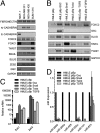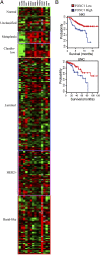Core epithelial-to-mesenchymal transition interactome gene-expression signature is associated with claudin-low and metaplastic breast cancer subtypes
- PMID: 20713713
- PMCID: PMC2932589
- DOI: 10.1073/pnas.1004900107
Core epithelial-to-mesenchymal transition interactome gene-expression signature is associated with claudin-low and metaplastic breast cancer subtypes
Erratum in
- Proc Natl Acad Sci U S A. 2010 Nov 2;107(44):19132
Abstract
The epithelial-to-mesenchymal transition (EMT) produces cancer cells that are invasive, migratory, and exhibit stem cell characteristics, hallmarks of cells that have the potential to generate metastases. Inducers of the EMT include several transcription factors (TFs), such as Goosecoid, Snail, and Twist, as well as the secreted TGF-beta1. Each of these factors is capable, on its own, of inducing an EMT in the human mammary epithelial (HMLE) cell line. However, the interactions between these regulators are poorly understood. Overexpression of each of the above EMT inducers up-regulates a subset of other EMT-inducing TFs, with Twist, Zeb1, Zeb2, TGF-beta1, and FOXC2 being commonly induced. Up-regulation of Slug and FOXC2 by either Snail or Twist does not depend on TGF-beta1 signaling. Gene expression signatures (GESs) derived by overexpressing EMT-inducing TFs reveal that the Twist GES and Snail GES are the most similar, although the Goosecoid GES is the least similar to the others. An EMT core signature was derived from the changes in gene expression shared by up-regulation of Gsc, Snail, Twist, and TGF-beta1 and by down-regulation of E-cadherin, loss of which can also trigger an EMT in certain cell types. The EMT core signature associates closely with the claudin-low and metaplastic breast cancer subtypes and correlates negatively with pathological complete response. Additionally, the expression level of FOXC1, another EMT inducer, correlates strongly with poor survival of breast cancer patients.
Conflict of interest statement
The authors declare no conflict of interest.
Figures





References
-
- Yang J, et al. Twist, a master regulator of morphogenesis, plays an essential role in tumor metastasis. Cell. 2004;117:927–939. - PubMed
-
- Sabbah M, et al. Molecular signature and therapeutic perspective of the epithelial-to-mesenchymal transitions in epithelial cancers. Drug Resist Updat. 2008;11(4-5):123–151. - PubMed
Publication types
MeSH terms
Substances
Associated data
- Actions
Grants and funding
LinkOut - more resources
Full Text Sources
Other Literature Sources
Medical
Molecular Biology Databases
Research Materials

